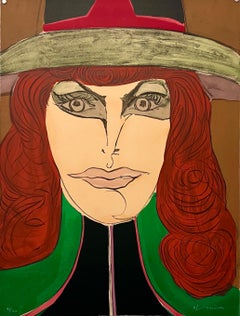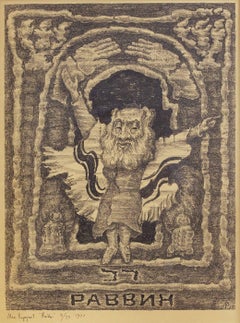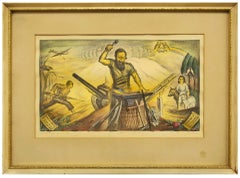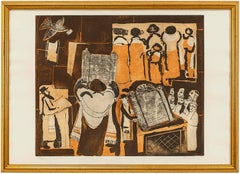Want more images or videos?
Request additional images or videos from the seller
1 of 7
Chaïm GoldbergChassidic Klezmer Fiddler
Price:$400
$550List Price
About the Item
- Creator:Chaïm Goldberg (1917-2004, Polish)
- Dimensions:Height: 24 in (60.96 cm)Width: 18 in (45.72 cm)
- More Editions & Sizes:Edition XXXXII / CLXXV
- Medium:
- Period:
- Condition:
- Gallery Location:Surfside, FL
- Reference Number:1stDibs: LU382750852
About the Seller
4.9
Platinum Seller
Premium sellers with a 4.7+ rating and 24-hour response times
Established in 1995
1stDibs seller since 2014
1,830 sales on 1stDibs
Typical response time: 1 hour
Authenticity Guarantee
In the unlikely event there’s an issue with an item’s authenticity, contact us within 1 year for a full refund. DetailsMoney-Back Guarantee
If your item is not as described, is damaged in transit, or does not arrive, contact us within 7 days for a full refund. Details24-Hour Cancellation
You have a 24-hour grace period in which to reconsider your purchase, with no questions asked.Vetted Professional Sellers
Our world-class sellers must adhere to strict standards for service and quality, maintaining the integrity of our listings.Price-Match Guarantee
If you find that a seller listed the same item for a lower price elsewhere, we’ll match it.Trusted Global Delivery
Our best-in-class carrier network provides specialized shipping options worldwide, including custom delivery.You May Also Like
TAKASHI MURAKAMI: Clairvoyance - Hand signed & numbered. Superflat, Pop Art
By Takashi Murakami
Located in Madrid, Madrid
CLAIRVOYANCE
Date of creation: 2016
Medium: Offset lithograph with silver on paper
Edition number: 185/300
Size: 68 x 68 cm
Observations: Offset lithograph with silver on paper hand ...
Category
2010s Pop Art Figurative Prints
Materials
Varnish, Lithograph, Offset
$3,600 / item
H 26.78 in W 26.78 in
TAKASHI MURAKAMI: KANSEI: KORIN RED STREAM Japanese Pop flowers red black
By Takashi Murakami
Located in Madrid, Madrid
Takashi Murakami - KANSEI: KORIN RED STREAM
Date of creation: 2010
Medium: Offset lithograph with cold stamp and high gloss varnishing on paper
Edition number: 39/300
Size: 71 cm Ø
C...
Category
2010s Pop Art Figurative Prints
Materials
Paper, Varnish, Lithograph, Offset
$5,754
H 27.96 in Dm 27.96 in
Starry Night - Limited Edition, Figurative, Contemporary, Star, Night, Child
By Charlie Mackesy
Located in Knowle Lane, Cranleigh
Starry Night is a lithograph based on a watercolour by Charlie Mackesy. The edition is limited to 150 and each piece has been signed by Charlie Mackesy...
Category
2010s Other Art Style Figurative Prints
Materials
Lithograph
$3,348
H 11.82 in W 7.88 in D 0.4 in
Girl on Gold - Limited Edition, Figurative, Contemporary, semi-nude, feminine
By Charlie Mackesy
Located in Knowle Lane, Cranleigh
Girl on Gold is a limited edition lithograph, based on an oil painting by Charlie Mackesy. The edition is limited to 120 and have been signed by Mackesy in Pencil. The elegance and femininity depicted in this image captures a feminine nature and emits beauty in the human form and a warmth with its golden hues.
"I am cautious to explain what I think the work is saying for fear of taking away from you something you have seen and I have not. I could conclude by saying that life is precious and faith is a journey and sometimes art can give a small glimpse of these moments seen, and unseen. I think GK...
Category
2010s Other Art Style Figurative Prints
Materials
Lithograph
$2,410 Sale Price
20% Off
H 22.25 in W 16.54 in D 1.19 in
'Tree of life'. Coloured lithograph. Signed, titled, dated and numbered EA 1/5
By Guillaume Cornelis van Beverloo (Corneille)
Located in Paris, FR
'Tree of life''. Coloured lithograph. Signed, titled, dated and numbered EA 1/5
This piece is accompanied with a certificate of authencity by the Corneille Foundation.
Corneille – G...
Category
1990s Other Art Style Figurative Prints
Materials
Lithograph
Antonia - Limited Edition, Figurative, Contemporary, semi-nude, female, feminine
By Charlie Mackesy
Located in Knowle Lane, Cranleigh
Antonia is a limited edition lithograph, based on a black pastel drawing, by Charlie Mackesy. The edition is limited to 150 and have been signed by Mac...
Category
Early 2000s Feminist Figurative Prints
Materials
Lithograph
$6,629
H 29.14 in W 20.87 in D 1.78 in
Girl-signed lithograph, figurative, contemporary, print, female, emotion, nude
By Charlie Mackesy
Located in Knowle Lane, Cranleigh
"Girl" by Charlie Mackesy is a highly sought-after piece of artwork. This limited edition lithograph, signed by the artist in pencil, is part of an edition of only 150 copies. The ar...
Category
Early 2000s Contemporary Figurative Prints
Materials
Lithograph
$11,383
H 31.5 in W 23.43 in D 1.38 in
Hand of Africa - Mandela, Former South African President, Signed Artwork, Hand
By Nelson Mandela
Located in Knowle Lane, Cranleigh
Nelson Mandela, Hand of Africa, Signed Limited Edition Lithograph
Many people are unaware that Nelson Mandela turned his hand to art in his 80's as a way of leaving a legacy for his ...
Category
Early 2000s Contemporary Figurative Prints
Materials
Lithograph
$20,089
H 25.5 in W 20 in D 2 in
Angel & Piano- Limited Edition, Figurative, Contemporary, Faith, Music, Angels
By Charlie Mackesy
Located in Knowle Lane, Cranleigh
Angel and Piano is a gentle and peaceful work showing a boy playing the piano with an angel over him.
It is a limited edition lithograph, based on an oil painting, and each work is signed in pencil by Charlie Mackesy...
Category
Early 2000s Other Art Style Figurative Prints
Materials
Lithograph
$3,348
H 28.35 in W 21.66 in D 1.19 in
Impressions of Africa - Mandela, Former South African President, Signed Artwork
By Nelson Mandela
Located in Knowle Lane, Cranleigh
Nelson Mandela, Impressions of Africa (black and white), Signed Limited Edition Lithograph
Many people are unaware that Nelson Mandela turned his hand to art in his 80's as a way of ...
Category
Early 2000s Contemporary Figurative Prints
Materials
Lithograph
$12,723
H 25.5 in W 20 in D 2 in
More From This Seller
View All1971 Modernist Lithograph Redhead Pop Art Mod Fashionable Woman Richard Lindner
By Richard Lindner
Located in Surfside, FL
RICHARD LINDNER (American. 1901-1978)
Hand Signed limited edition lithograph with blindstamp
Publisher: Shorewood-Bank Street Atelier for the Skowhegan School of Painting and Sculpture
29.25 X 22 inches
Richard Lindner was born in Hamburg, Germany. In 1905 the family moved to Nuremberg, where Lindner's mother was owner of a custom-fitting corset business and Richard Lindner grew up and studied at the Kunstgewerbeschule (Arts and Crafts School since 1940 Academy of Fine Arts). From 1924 to 1927 he lived in Munich and studied there from 1925 at the Kunstakademie. In 1927 he moved to Berlin and stayed there until 1928, when he returned to Munich to become art director of a publishing firm. He remained there until 1933, when he was forced to flee to Paris, where he became politically engaged, sought contact with French artists and earned his living as a commercial artist. He was interned when the war broke out in 1939 and later served in the French Army. In 1941 he went to the United States and worked in New York City as an illustrator of books and magazines (Vogue, Fortune and Harper's Bazaar). He began painting seriously in 1952, holding his first one-man exhibit in 1954. His style blends a mechanistic cubism with personal images and haunting symbolism. LIndner maintained contact with the emigre community including New York artists and German emigrants (Albert Einstein, Marlene Dietrich, Saul Steinberg). Though he became a United States citizen in 1948, Lindner considered himself a New Yorker, but not a true American. However, over the course of time, his continental circus women became New York City streetwalkers. New York police uniforms replaced European military uniforms as symbols of authority.At a time when Abstract Expressionism was all the rage, Lindner’s painting went against the current and always kept its distance. His pictorial language of vibrant colours and broad planes of colour and his urban themes make him a forerunner of American Pop Art. At the same time, he owes the critical tone of his paintings to the influence of European art movements such as Neue Sachlichkeit and Dada. His first exhibition did not take place until 1954, by which time he was over fifty, and, interestingly, it was held at the Betty Parsons Gallery in New York, a venue associated with the American Expressionists. From 1952 he taught at the Pratt Institute, Brooklyn, from 1967 at Yale University School of Art and Architecture, New Haven. In 1957 Lindner got the William and Norma Copley Foundation-Award. In 1965 he became Guest Professor at the Akademie für Bildende Künste, Hamburg. His Ice (1966, Whitney Museum of American Art) established a connection between the metaphysical tradition and pop art. He did work on Rowlux which was used by a number of pop artists (most notably Roy Lichtenstein)The painting shows harsh, flat geometric shapes framing an erotic but mechanical robot-woman. His paintings used the sexual symbolism of advertising and investigated definitions of gender roles in the media. While influencing Pop Art (Andy Warhol, Tom Wesselmann and Claes Oldenburg amongst others) his highly colourful, hard-edge style seems to have brought him close to Pop Art, which he rejected. Nevertheless, he is immortalised on the cover of the Beatles record "Sgt. Pepper’s Lonely Hearts Club Band" (1967) as a patron of the pop culture. He also did a tapestry banner with the Betsy Ross Flag...
Category
1970s Pop Art Abstract Prints
Materials
Lithograph
The Rabbi 1977 Soviet Non Conformist Avant Garde Print
By Alek Rapoport
Located in Surfside, FL
Dimensions w/Frame: 25 3/4" x 20 3/4"
Alek Rapoport (November 24, 1933, Kharkiv, Ukraine SSR – February 4, 1997, San Francisco) was a Russian Nonconformist artist, art theorist and teacher.
Alek Rapoport spent his childhood in Kiev (Ukraine SSR). During Stalin's "purges" both his parents were arrested. His father was shot and his mother spent ten years in a Siberian labor camp. Rapoport lived with his aunt. At the beginning of World War II, he was evacuated to the city of Ufa (the Bashkir Autonomous Soviet Socialist Republic). A time of extreme loneliness, cold, hunger and deprivation, this period also marked the beginning of Rapoport's drawing studies.
After the war, Rapoport lived in Chernovtsy (Western Ukraine), a city with a certain European flair. At the local House of Folk Arts, he found his first art teacher, E.Sagaidachny (1886–1961), a former member of the nonconformist artist groups Union of the Youth (Soyuz Molodyozhi) and Donkey's Tail, popular during the 1910s–1920s. His other art teacher was I. Beklemisheva (1903–1988). Impressed by Rapoport's talent, she later (1950) organized his move to Leningrad, where he entered the famous V.Serov School of Art (the former School of the Imperial Society for the Promotion of Arts, OPKh, later the Tavricheskaya Art School).
His association with this school lasted eight years, first as a student, and then, from 1965 to 1968, as a teacher. With "Socialist realism" the only official style during this time, most of the art school's faculty had to conceal any prior involvement in non-conformist art movements. Ya.K.Shablovsky, V.M.Sudakov, A.A.Gromov introduced their students to Constructivism only through clandestine means.
(1959–1963) Rapoport studied stage design at the Leningrad Institute of Theater, Music and Cinema under the supervision of the famous artist and stage director N.P.Akimov. Akimov taught a unique course based on theories of Russian Suprematism and Constructivism, while encouraging his graduate students to apply their knowledge to every field of art design. Despite differences in personal artistic taste with Akimov, who was drawn to Vermeer and Dalí, Rapoport was influenced by Akimov's personality and liberalism, as well as the logical style of his art.
In 1963, Rapoport graduated from the institute. His highly acclaimed MFA work involved the stage and costume design for I.Babel's play Sunset. In preparation, he traveled to the southwest regions of the Soviet Union, where he accumulated many objects of Judaic iconography from former ghettos, disappearing synagogues and old cemeteries. He wandered Odessa in search of Babel's characters and the atmosphere of his books.
He organized a new liberal course in technical aesthetics, introducing his students to Lotman's theory of semiotics, the Modulor of Le Corbusier, the Bauhaus school, Russian Constructivism, Russian icons and contemporary Western art. As a result of his "radicalism," Rapoport was fired for "ideological conspiracy."
He sought to cultivate himself as Jewish artist. This became particularly noticeable after the Six-Day War, when the Israeli victory led intellectuals, including the Jewish intelligentsia, to feel a heightened interest in Jewish culture and its Biblical roots. Rapoport's works of this period include Three Figures, a series of images of Talmudic Scholars, and works dealing with anti-Semitism. In the 1970s Rapoport joined the non-conformist movement, which opposed the dogmas of "Socialist realism" in art, along with Soviet censorship. The movement sought to preserve the traditions of Russian iconography and the Constructivist/Suprematist style of the 1910s. Despite the authorities' persecutions of nonconformist artists (including arrests, forced evictions, terminations of employment, and various forms of routine hassling), they united in a group, "TEV – Fellowship of Experimental Exhibitions." TEV's exhibitions proved tremendously successful.
In the same period, Rapoport became one of the initiators of another anti-establishment group, ALEF (Union of Leningrad's Jewish Artists). In the United States this group was known as "Twelve from the Soviet Underground." Rapoport's involvement with this group increased tension with the authorities and attracted KGB scrutiny, including "friendly conversations," surveillance, detentions and house arrests. It became increasingly dangerous for him to live and work in the USSR. In October 1976, Rapoport with his wife and son were forced to leave Russia.
In Italy, Rapoport exhibited at the Venice Biennale, "La Nuova Arte Sovietica-Una prospettiva non-ufficiale" (1977), participated in television programs about nonconformist art in the Soviet Union, and created lithographic works continuing his theme of Jewish characters from Babel's play Sunset.
In 1977, Rapoport's family was granted U.S. immigration status and settled in San Francisco. a significant event in Rapoport's life occurred in his meeting with San Francisco gallery owner Michael Dunev, who became his friend and representative, organizing all his exhibitions until the artist's death.
Toward the end of the 1980s and beginning of the 1990s, Rapoport completed his most ambitious works on the theme of the Old Testament prophets: Samson Destroying the House of the Philistines (1989), Lamentation and Mourning and Woe (1990), the four paintings Angel and Prophets (1990–1991) and Three Deeds of Moses (1992).
In 1992, the artist's friends in St. Petersburg organized the first exhibition of his works there since his departure into exile, with works patiently gathered from collectors and art museums. This exhibition, held in the City Museum of St. Petersburg and accompanied by headlines such as "A St. Petersburg artist returns to his town," was followed by much larger ones in 1993 (St. Petersburg and Moscow), organized in collaboration with Michael Dunev Gallery under the name California Branches – Russian Roots.
He Exhibited in "Soviet Artists, Jewish Themes...
Category
1970s Post-Modern Figurative Prints
Materials
Lithograph
AFTER THE VICTORY, PROPHECY OF ISAIAH, WPA ERA Circa 1930s
By Saul Rabino
Located in Surfside, FL
A wartorn composition of a soldier on the left, a Jewish blacksmith in the middle and a little shepherd on the right. This is a lithograph pastel and colored pencil on paper.
Saul Rabino (1892-1969)Best known for his paintings and drawings of Jewish culture, Saul Rabino was a Russian-bornartist who spent most of his life in Los Angeles. Born Saul Rabinowitz in 1892 in Odessa, Russia,Rabino studied art at the Russian Imperial Art School. During a brief stay in Paris, he continued hiseducation at the École des Arts Decoratifs. After mastering techniques in painting, sculpture, andlithography, Rabino moved to Los Angeles, where he worked as a WPA printmaker during the1930s. He stayed in Los Angeles for the rest of his life, making work about political turmoil and theJewish community. During the 1940s, he drew allegorical images of war and the plight of Jewsin Eastern Europe. These political works, usually drawings or prints, are dramatic, symbolic, andemotionally rousing. He also made art portraying the scholars and religious leaders of the Jewishcommunity, including portraits that are more delicate than his political pieces and express anobvious admiration for the leaders of his community. Before he died in 1969, Rabino exhibitedat the World’s Fair New York in 1939, the Los Angeles Museum Historical Society of Art, and theLaguna Beach Art Society. His work is in the collection of the Los Angeles Public...
Category
1930s Modern Figurative Prints
Materials
Pastel, Color Pencil, Lithograph
Prayer, Torah, and the Dove
By Lennart Rosensohn
Located in Surfside, FL
Ed. 54/180
Mauritz Lennart Rosensohn , born July 25, 1918 in Malmö, Denmark, died in 1994, was a Swedish artist and graphic artist .
He was the son of merchant Viktor Rosensohn and Anna Jacobsohn and from 1955 married to actor Asta Nyström . Rosensohn studied at the Technical School in Malmö in 1938 and at Skånska School of Painting...
Category
20th Century Modern Figurative Prints
Materials
Lithograph
1936 Lithograph Interregnum, Cigar, Kid w Toy Gun, Small Edition Weimar Germany
By George Grosz
Located in Surfside, FL
Hand lithography on BFK Rives French hand moulded paper Style: German New Objectivity (Neue Sachlichkeit)
According to the frontis these were produced by Hand Lithography. According...
Category
1930s Modern Interior Prints
Materials
Lithograph
Columbus, Ohio State Artist Judaica Wedding Engagement Lithograph
By Sid Chafetz
Located in Surfside, FL
Description:
Medium: Lithograph. Hand signed
Print Image Size: 23 3/8 x 18 1/8 inches.
Print Edition: no edition. this is marked B.A.T.
Alternate Medium: Lithograph.
Ink(s): black.
Support: grey wove paper.
Double portrait of the artist's aunt and uncle at their engagement, with Sophie standing next to a seated Robert Cohen. Text at the top reads "Sophie, born in Navaredek, Belarus, April 5, 1899, died in Providence, Jan 3, 1991. Robert, born in July 4, 1890 in Providence, R.I., Died in Providence, March, 1987. Engagement photo of Sophie Pearl Gabrilowitz and Robert Maurice Cohen...
Category
1990s Modern Figurative Prints
Materials
Archival Paper, Lithograph
Recently Viewed
View AllMore Ways To Browse
Vintage Stone Figurine
Little Figurine
Golda Meir
Giovanni Battista Piranesi Vaso Di Marmo Antico Che Si Vede Nel Museo Capitolino Etching 1778
Grace Albee
Gustave Adolph Hoffman On Sale
H Hargrove
H Otsuka
Helen Hyde On Sale
Henri Cartier Bresson Poster
Henri Matisse Plate 4
Henrik Simonsen
Henry Casselli
Henry Moore Elephant
Henry Moore Sheep
Henry Wilkinson Etching
Herbert Matter Vintage Airline Poster
Herman Wessel



